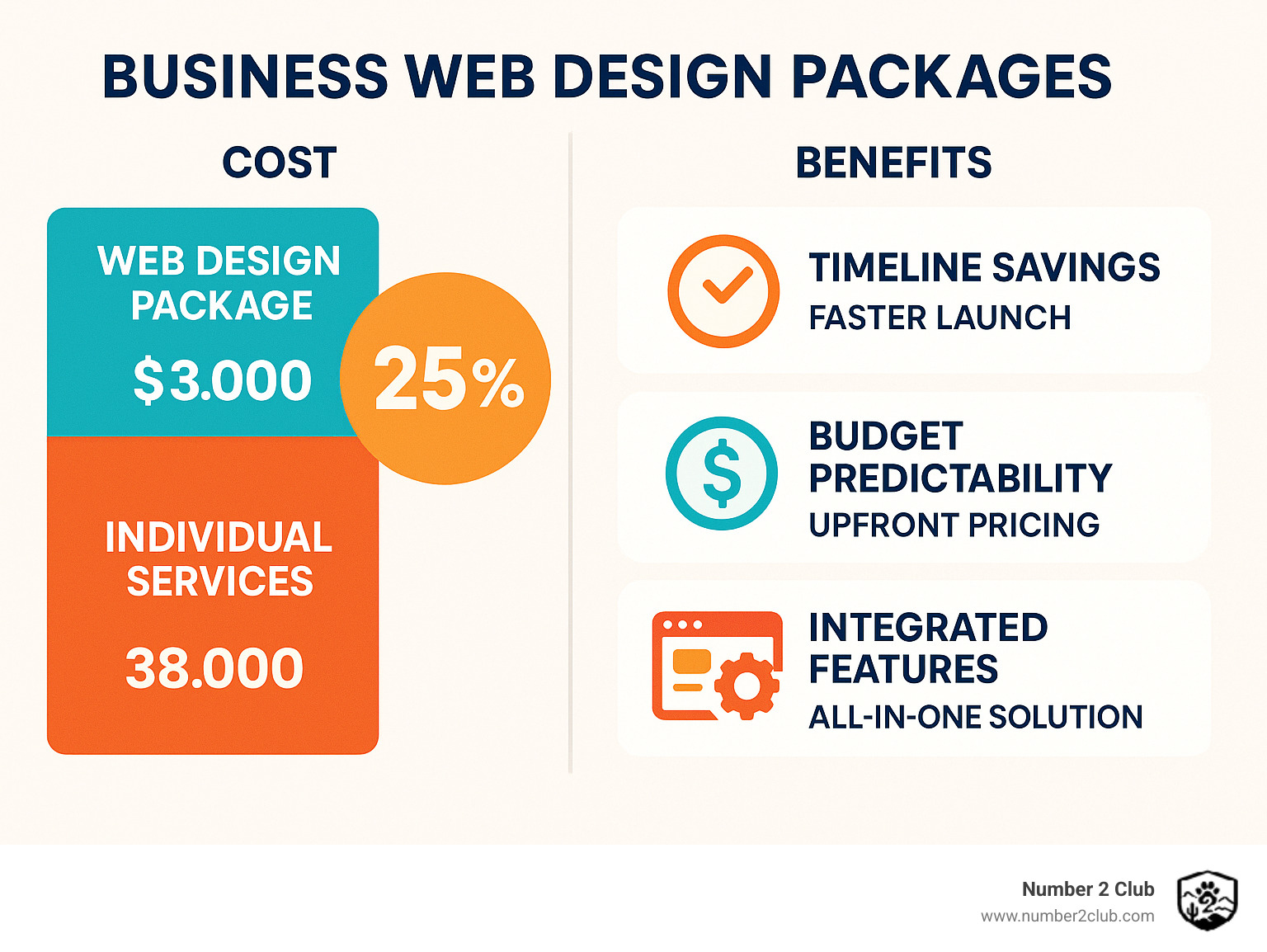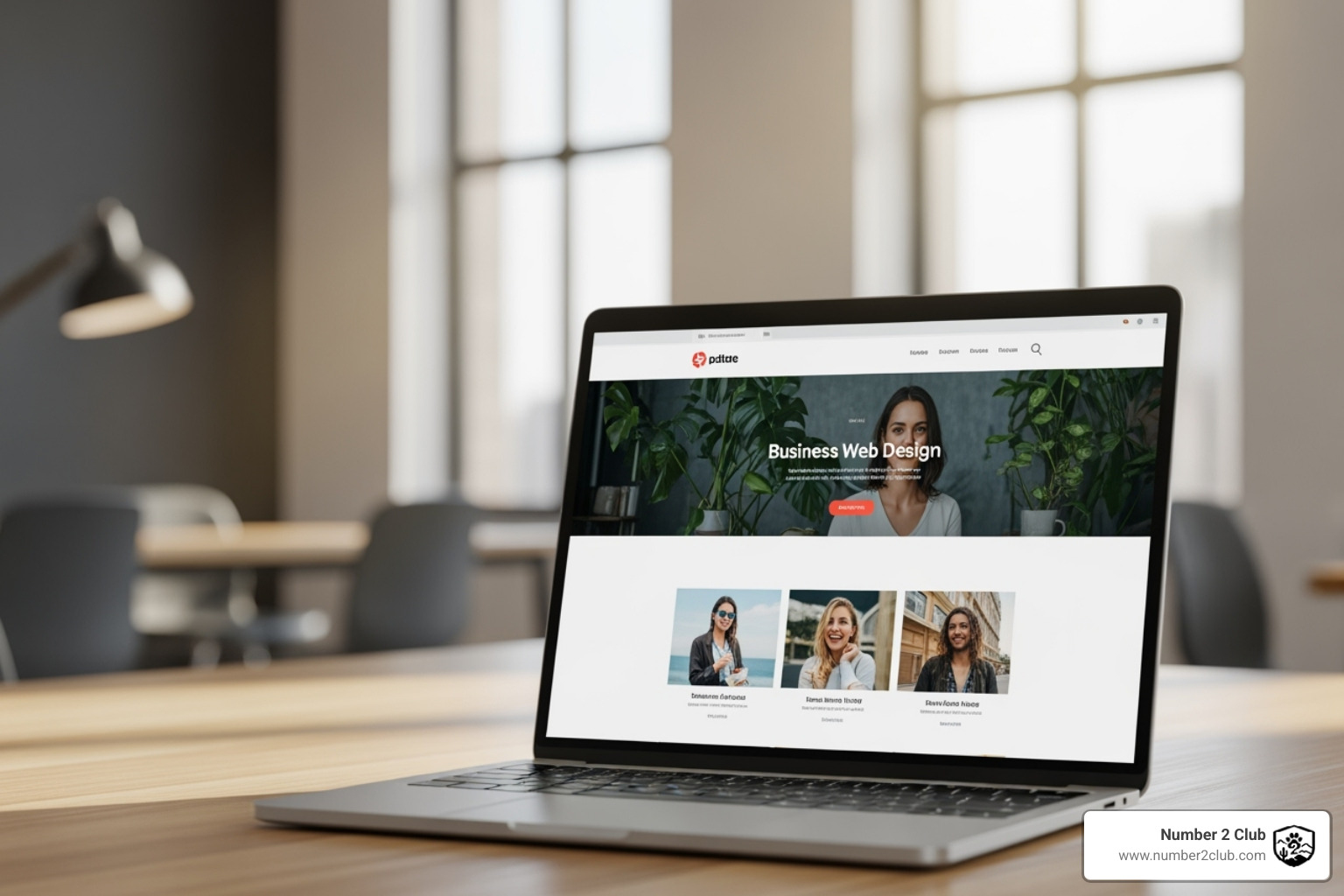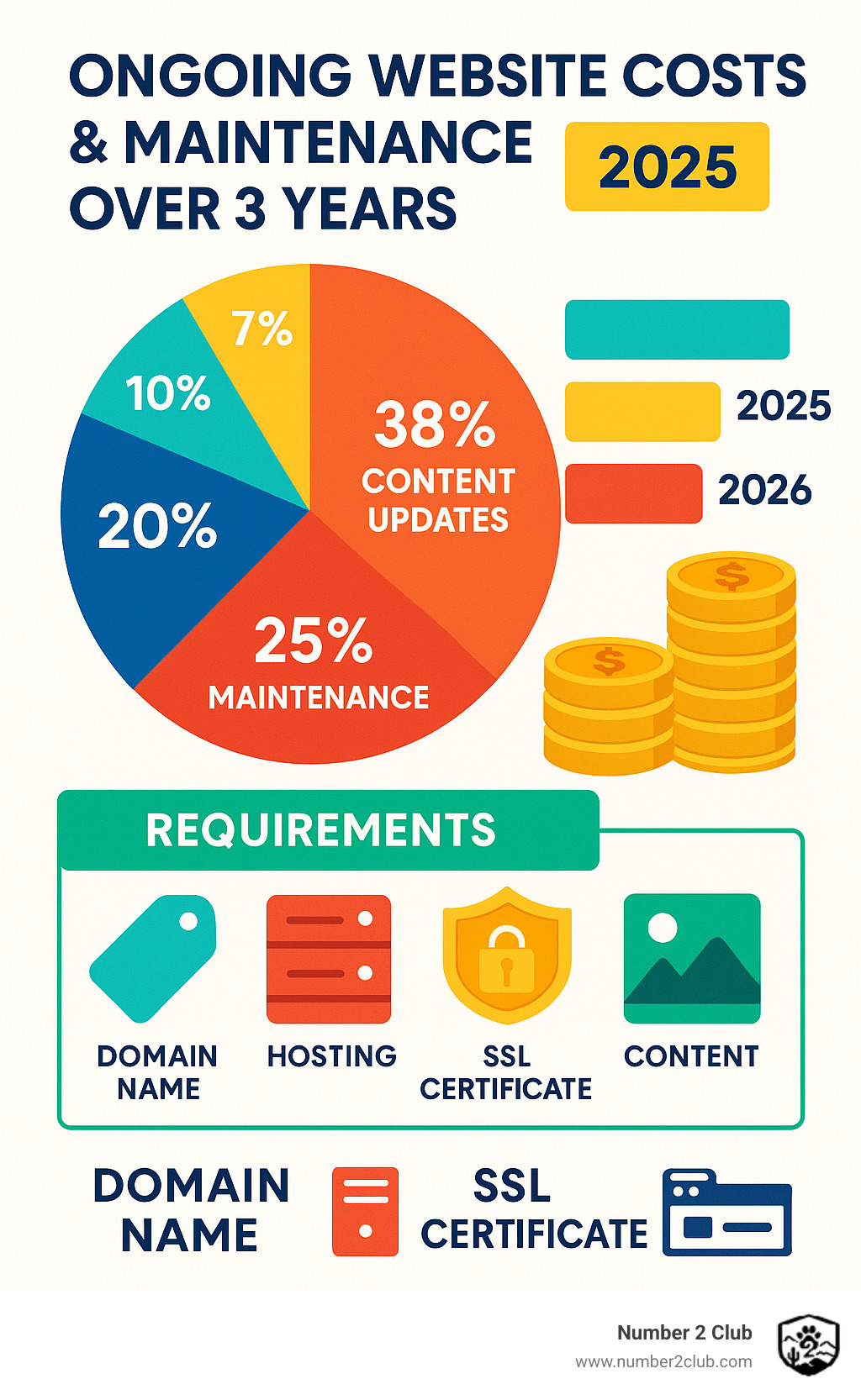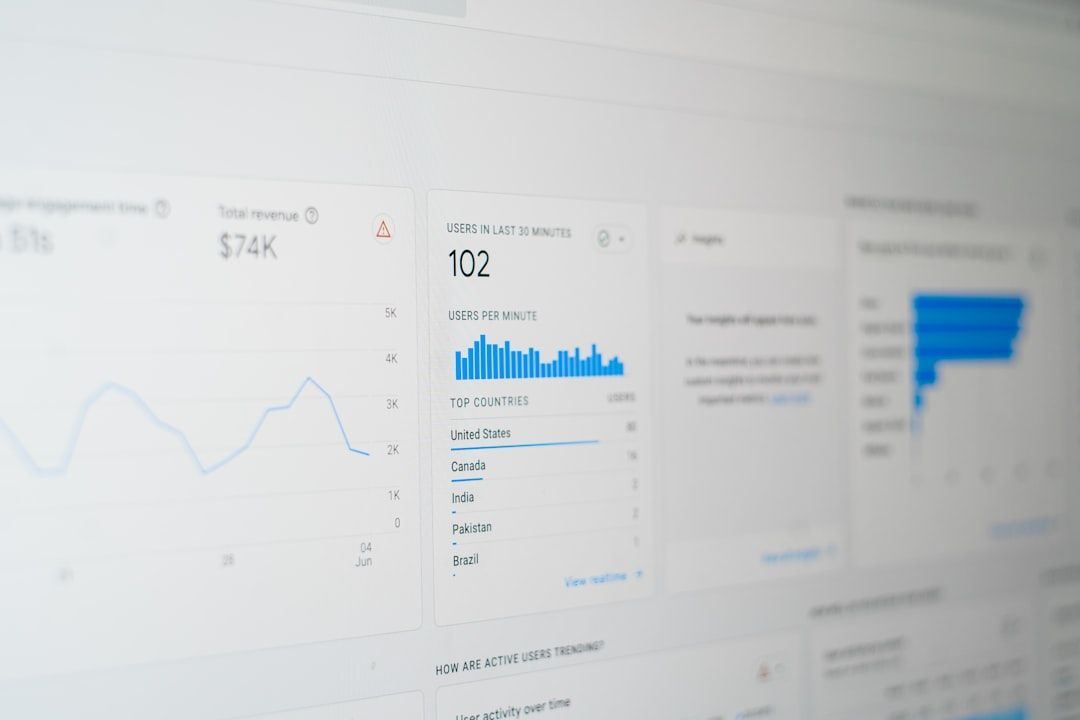The Ultimate Showdown of Business Web Design Packages
Why Business Web Design Packages Are the Smart Choice for Small Business Owners
Business web design packages offer small businesses a comprehensive, cost-effective solution for establishing their online presence without the complexity of managing multiple vendors or services.
Quick comparison of business web design packages:
- Basic packages ($500-$2,000): 1-5 pages, template design, contact forms, mobile-friendly
- Standard packages ($2,000-$8,000): 5-15 pages, custom elements, CMS integration, basic SEO
- Premium packages ($8,000-$25,000+): 15+ pages, fully custom design, advanced features, content creation
- E-commerce packages ($3,000-$10,000+): Online store functionality, payment processing, inventory management
The reality is simple: most basic websites cost between $3,000 to $8,000, but choosing a package deal typically saves 25% compared to piecing together individual services. These bundled solutions eliminate the headache of coordinating between designers, developers, and content creators while ensuring all components work together seamlessly.
Package deals also provide predictable pricing upfront. No surprise bills for "extra revisions" or hidden fees that can derail your budget halfway through the project.
I'm Joseph Lopez nc, and through my work building digital solutions for service-based businesses, I've seen how the right business web design packages can transform a company's ability to attract and retain customers online. My experience helping businesses establish their digital presence has shown me that package deals consistently deliver better value and fewer headaches than piecemeal approaches.

Decoding the Different Tiers of Business Web Design Packages
When you're shopping for business web design packages, you'll quickly find that the options can feel overwhelming. But here's the thing - the web design world has naturally organized itself into tiers that make perfect sense once you understand what you're looking at.
Think of it like shopping for a car. You wouldn't expect a Honda Civic to have the same features as a BMW, right? The same logic applies to web design packages. Each tier serves different business needs, budgets, and growth stages.
After working with hundreds of businesses on their web design projects, I've noticed clear patterns in how these packages are structured. Let me break down what you can realistically expect at each level:
| Package Tier | Price Range | Target Audience | Key Features |
|---|---|---|---|
| Basic | $500-$2,000 | Startups, very small businesses | Template design, 1-5 pages, contact forms |
| Standard | $2,000-$8,000 | Small to medium businesses | Custom elements, 5-15 pages, CMS, basic SEO |
| Premium | $8,000-$25,000+ | Established businesses | Fully custom, 15+ pages, advanced features |
| E-commerce | $3,000-$10,000+ | Online retailers | Shopping cart, payment processing, inventory |
The key is matching your choice to where your business actually is today - not where you hope it'll be in five years. Let's explore what each tier really offers.
What to Expect from Basic business web design packages ($500 - $2,000)
Basic packages are perfect for businesses just dipping their toes into the digital world. If you're a startup or small local business that needs to establish some online credibility without breaking the bank, this is your starting point.
Here's what you'll typically get: template-based design with limited customization, usually covering your essential pages like Home, About, Services, and Contact. Your site will be mobile-friendly(thankfully, this is standard everywhere now) and include basic contact forms that send inquiries straight to your email.
The navigation stays simple and clean, and you'll get basic SEO setup including meta tags and proper site structure. It's straightforward, professional, and gets the job done.
But here's something important to consider - most businesses find they need at least 3-5 pages to properly represent their services and build trust with potential customers. A single-page website might not give visitors the best impression of your professionalism.
Basic packages work brilliantly for service-based businesses that generate most of their work through referrals and local networking. Think local contractors, consultants, or small service providers who need an online presence but don't require complex functionality.
More info about our process if you're wondering whether a basic package fits your business needs.
What to Expect from Standard Packages ($2,000 - $8,000)
Standard packages hit the sweet spot for most growing businesses. This is where things get interesting - you're moving beyond basic templates into custom design elements that can actually set your business apart from competitors.
With standard packages, you'll get 5-15 pages of content, giving you room to really explain your services in detail. The Content Management System (CMS) integration- typically WordPress - means you can update your own content without calling your designer every time you want to change something.
Blog integration becomes a game-changer here. You can start building your content marketing strategy, and the improved SEO setup includes keyword optimization and better site structure. Add in social media integration, professional email setup with your domain name, and basic analytics integration to track how visitors use your site.
Most businesses see standard packages as their "growth phase" investment. You're not just establishing a web presence anymore - you're actually using your website as a marketing tool.
The training that comes with most standard packages is crucial. Being able to add blog posts, update service information, and manage your own content gives you the flexibility to respond to market changes quickly.
Tips for Increasing Site Traffic becomes particularly valuable at this level, since you'll have the tools to implement real content marketing strategies.
What to Expect from Premium business web design packages ($8,000 - $25,000+)
Premium packages are where web design becomes truly strategic. These aren't just websites - they're comprehensive digital marketing platforms designed specifically to drive business growth.
Everything is fully custom design created specifically for your brand and industry. You'll get 15+ pages with detailed content architecture, plus advanced functionality like appointment booking systems, client portals, or custom calculators that serve your specific business needs.
The comprehensive SEO strategy includes keyword research and competitive analysis - not just basic setup. Professional content creation with copywriting and photography ensures your message resonates with your target audience.
E-commerce integration, API integrations with your existing business tools, advanced security features, and conversion optimization strategies all get built into the design from the ground up.
Premium packages make sense for established businesses with annual revenues of $100,000+ that understand their website's role in revenue generation. These businesses view their website as a critical business asset, not just an online brochure.
The results speak for themselves - businesses investing in premium packages often see significantly more high-quality leads compared to their previous websites. The combination of professional design, strategic content, and conversion optimization creates a compound effect on business growth.
What to Expect from E-commerce Packages ($3,000 - $10,000+)
E-commerce packages deserve special attention because selling online requires specialized functionality that goes way beyond traditional business websites.
The product catalog management handles unlimited products and categories, while the shopping cart functionality includes abandoned cart recovery to capture sales you might otherwise lose. Secure payment processing through multiple gateways gives your customers flexibility, and inventory management with real-time stock tracking keeps everything organized.
Order management systems streamline processing and fulfillment, while customer account creation and management build loyalty. The SSL certificate ensures secure transactions, and mobile-optimized checkout processes are essential since many customers shop on their phones.
Tax calculation and shipping integration handle the complex logistics, while digital gift cards and coupon systems give you marketing flexibility.
The complexity explains why these packages start at $3,000 even for basic functionality. E-commerce sites need ongoing attention - inventory updates, security patches, and payment system maintenance. But many businesses find the investment worthwhile when they consider the 24/7 sales potential and ability to reach customers far beyond their local market.
The Anatomy of a Quality Web Design Project
When you're investing in business web design packages, understanding what actually goes into creating a quality website helps you make smarter decisions. Think of it like buying a house – you want to know what's behind the walls, not just admire the paint job.

Key Features Every Quality Package Must Include
No matter which package tier fits your budget, certain features are absolutely essential in today's digital world. These aren't nice-to-have extras – they're the foundation that determines whether your website actually helps your business grow.
Responsive design is your website's ability to look great and work perfectly whether someone visits on their phone, tablet, or desktop computer. Since most people now browse on mobile devices, a website that doesn't work on smartphones is essentially broken. Quality packages build this in from the ground up, not as an afterthought.
The mobile-first approach goes beyond just making things fit smaller screens. It means designing for mobile users first, then enhancing the experience for larger screens. This approach creates faster, cleaner websites that work better for everyone.
A Content Management System (CMS) gives you the power to update your own website without needing to call a developer every time you want to change a phone number or add a new service. Most quality packages use WordPress because it's reliable, flexible, and doesn't require a computer science degree to operate.
Search Engine Optimization (SEO) isn't optional anymore – it's how people find your business online. Quality packages include proper meta tags, clean URL structures, and fast loading speeds that help search engines understand and rank your website. Without basic SEO, you're essentially invisible online.
Security features protect both your business and your visitors. Every website needs an SSL certificate, which encrypts information and shows that little lock icon in browsers. Google actually penalizes websites without SSL certificates, so this directly affects your search rankings.
Fast loading speed might seem technical, but it's crucial for keeping visitors on your site. People expect websites to load in under three seconds, and search engines favor faster sites. Quality packages optimize images, use clean code, and choose reliable hosting to ensure your site loads quickly.
User-friendly navigation means visitors can find what they're looking for without getting frustrated. The best websites guide people naturally toward taking action – whether that's calling your business, filling out a contact form, or making a purchase.
Clear call-to-action (CTA) elements tell visitors exactly what you want them to do next. These might be "Call Now" buttons, contact forms, or "Get a Quote" links positioned strategically throughout your site.
The Typical Web Design Process: From Consultation to Launch
Quality business web design packages follow a proven process that minimizes surprises and ensures you get exactly what your business needs. Here's how the best projects unfold:
Findy and Strategy is where everything begins. This isn't just a quick phone call – it's a deep dive into understanding your business goals, target customers, and what makes you different from competitors. Good designers ask lots of questions because they know that great websites solve specific business problems.
Wireframing and Prototyping creates the blueprint before any visual design begins. Think of wireframes as the floor plan of your website – they show where everything goes without getting distracted by colors or fonts. This step prevents costly changes later in the process.
Design Mockups bring your website to life visually. This is where your brand colors, fonts, and imagery come together to create the look and feel of your site. Quality packages include multiple design concepts and revisions to ensure you love the final result.
Development and Coding transforms those beautiful designs into a functioning website. Modern development uses clean, efficient code that loads quickly and works reliably across all devices and browsers.
Content Integration is where your text, images, and other materials get added to the website structure. Many businesses underestimate how important this step is – even the best design falls flat without compelling content that speaks to your customers.
Testing and Quality Assurance catches problems before your customers do. This includes checking functionality across different devices and browsers, testing forms and contact methods, and ensuring everything works smoothly.
Launch and Training gets your website live and teaches you how to manage it. Quality packages include training sessions so you feel confident updating content, adding blog posts, and making minor changes yourself.
Most quality projects take 6-8 weeks from start to finish, though the timeline often depends more on how quickly you provide content and feedback than on the technical development time. The Easiest WordPress Page Builder tools have streamlined much of this process, allowing for faster completion without sacrificing quality.
This structured approach ensures that every element of your website works together to support your business goals, rather than just looking pretty.
Understanding the Price Tag: Costs, Factors, and Hidden Fees
Let's talk money. When you're shopping for business web design packages, understanding what drives pricing helps you make smart decisions and avoid budget surprises down the road.
Think of web design pricing like buying a house - the final cost depends on size, location, custom features, and ongoing maintenance. The same principle applies to websites.

Factors That Influence Web Design Pricing
Website complexity is the biggest price driver. A simple 5-page website takes a fraction of the time compared to a 20-page site loaded with custom features. Every addition - contact forms, photo galleries, appointment booking systems - requires additional development time and expertise.
Custom versus template design creates a significant pricing gap. Template-based designs can be implemented quickly since the foundation already exists. Custom designs, however, require original artwork, multiple design rounds, and unique coding solutions. This explains why custom design packages typically start around $5,000, while template solutions can begin as low as $500.
Page count directly correlates with pricing tiers. Our research shows clear patterns: 1-5 pages typically cost $500-$2,000, while 5-15 pages jump to $2,000-$8,000, and sites with 15+ pages often reach $8,000-$25,000+.
E-commerce functionality adds layers of complexity that standard websites don't require. Payment processing, inventory management, and security requirements explain why e-commerce packages start at $3,000 even for basic online stores.
Content creation often catches businesses off guard. Many packages assume you'll provide your own text and images. Professional copywriting and photography can add $1,000-$5,000 to your project cost, but the investment often pays for itself through improved conversion rates.
Agency team experience affects pricing significantly. Experienced professionals command higher rates - typically $50 to $200+ per hour - but usually deliver better results faster. This expertise difference explains the pricing gap between basic and premium packages.
Common Hidden Costs and Ongoing Expenses to Anticipate
Smart business owners budget beyond the initial package price. Here's what to expect after your website launches:
Domain name registration costs $10-20 annually for your website address. While inexpensive, this ongoing expense sometimes surprises businesses when packages only include the first year.
Website hosting is where your website files live on the internet. Basic hosting starts around $5 monthly, while high-performance hosting for busy sites can cost $50+ monthly. E-commerce sites typically need more robust hosting due to security and performance demands.
SSL certificates are now essential for credibility and search rankings. Many hosting providers include basic SSL certificates, but advanced certificates for e-commerce sites may cost $50-200 annually.
Premium plugins and themes improve WordPress functionality. Essential tools for advanced contact forms, SEO optimization, or security improvements typically cost $100-500 annually.
Website maintenance plans keep your site healthy through regular updates, security monitoring, and backups. These services typically cost $85-200 monthly depending on the service level.
Content updates present an interesting choice. While most packages include training for self-management, many businesses prefer professional content management services. Budget $500-2,000 monthly if you want ongoing professional content updates.
Future redesigns are inevitable. The research suggests refreshing your website design every 2-3 years and considering major overhauls every 3-5 years to stay current with design trends and technology.
Helpful resources for Canadian businesses can provide additional guidance on budgeting for digital investments.

The key to successful budgeting is thinking beyond the initial investment. A $5,000 website might seem expensive until you factor in the ongoing costs of maintaining an outdated site or losing customers to competitors with better online presence.
Frequently Asked Questions about Web Design Packages
How often should I redesign my business website?
Your website isn't a "set it and forget it" investment - it needs regular attention to stay effective. Think of it like maintaining your storefront; you wouldn't let it look outdated for years, right?
Plan for a design refresh every 2-3 years to keep your site looking modern and engaging. This doesn't mean starting from scratch - often it's about updating colors, fonts, images, and tweaking the layout to match current design trends.
Consider a major overhaul every 3-5 years when technology advances or your business has significantly evolved. This is when you might add new functionality, restructure your content, or completely reimagine your online presence.
However, don't wait for the calendar to tell you when to redesign. Your website might need attention sooner if your business has grown substantially, your current site isn't generating leads effectively, or you're noticing high bounce rates. Sometimes a competitor launches a stunning new website that makes yours look dated by comparison.
The investment for redesigns typically ranges from a few thousand to tens of thousands of dollars, depending on how extensive the changes need to be. Business web design packages for redesigns often cost less than starting from scratch since the content strategy and basic structure already exist.
Will I be able to update the website myself after it's built?
Absolutely! One of the biggest advantages of modern business web design packages is giving you control over your own content. Gone are the days when you needed to call a developer every time you wanted to change a phone number or add a new service.
Most quality packages include comprehensive training on your Content Management System, usually WordPress. These training sessions walk you through everything from adding new pages to updating existing content. Many providers even record these sessions so you can reference them later or train additional team members.
The backend of modern websites is designed for non-technical users. You can update text, add blog posts, change images, and modify contact information as easily as using a word processor. The interface is intuitive - if you can use email or social media, you can manage your website content.
You'll also get ongoing support during the initial months after launch. Most packages include 30 days to 3 months of post-launch support where you can get help with questions or minor adjustments. This safety net ensures you feel confident managing your site independently.
Multiple team members can have access with different permission levels. Your marketing person might be able to write blog posts, while your office manager handles contact information updates. This flexibility helps keep your website current without bottlenecks.
What's more important: website design or website content?
This question comes up constantly, and honestly, it's like asking whether the engine or steering wheel is more important in a car. Both design and content are critical and work together to create a successful online presence.
Great design keeps users engaged by creating immediate credibility and encouraging visitors to explore your site. Poor design can cause potential customers to leave within seconds, regardless of how valuable your content might be. First impressions matter tremendously online.
Great content provides value and drives conversions by addressing customer needs and clearly communicating your value proposition. Even the most beautiful website won't generate business without compelling content that speaks to your audience's problems and positions you as the solution.
Search engines evaluate both elements when ranking your website. They look at technical design factors like loading speed, mobile-friendliness, and clean code structure. They also analyze content relevance, quality, and how well it matches what people are searching for.
The most successful business web design packages address both design and content strategically rather than treating them as separate elements. Both are critical and work together- attractive design draws people in, while engaging content keeps them interested and converts them into customers.
The smart approach is investing in packages that handle both professionally, rather than trying to excel in one area while neglecting the other. Your website needs to look great AND communicate effectively to achieve your business goals.
Helpful resources for Canadian businesses can provide additional insights into creating effective online presences that balance both design and content considerations.
Conclusion: Making the Right Investment for Your Digital Future
Your website will likely be working for your business long after you've forgotten what you paid for it. That's why choosing the right business web design packages matters so much - it's not just about today's needs, but about building a foundation for tomorrow's growth.
Think about where your business is right now. If you're just starting out, a basic package might be perfect for establishing credibility and getting found online. But if you're already established and ready to use your website as a serious marketing tool, investing in a standard or premium package often pays for itself within the first year through increased leads and conversions.
The math is pretty straightforward- most businesses save about 25% by choosing package deals over piecing together individual services. More importantly, you avoid the headache of coordinating between different vendors and the risk of components that don't work well together.
Here's what really matters when making your decision: be honest about your budget and realistic about your timeline. A basic package that launches next month is better than a premium package that stays in planning mode for six months. You can always upgrade later as your business grows.
Remember those ongoing costs we discussed - domain registration, hosting, and maintenance. These aren't huge expenses, but they're part of owning a website. Budget for them upfront so there are no surprises later.
Mobile-friendliness and basic SEO aren't negotiable anymore. Every package you consider should include these as standard features, not expensive add-ons. Your customers are searching on their phones, and Google expects your website to work perfectly on mobile devices.
The businesses that get the most value from their websites are those that view them as long-term investments rather than one-time expenses. Your website should grow with your business, not hold it back.
We've helped countless businesses find the right fit for their needs and budget. Our Blog shares practical insights about making your website work harder for your business, and you can see real examples of our work, like our project for dog waste removal services , to understand how a professional website serves local businesses.
The best time to invest in your website was yesterday. The second best time is today. Your competitors are already online, and your potential customers are looking for businesses like yours right now. Make sure they can find you, and make sure what they find represents your business professionally.
Your digital presence will become one of your most valuable business assets. Choose a package that sets you up for success, not just for today, but for years to come.













